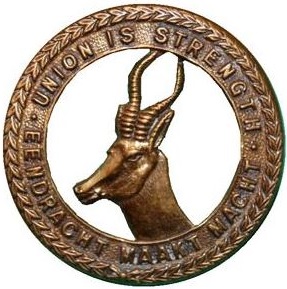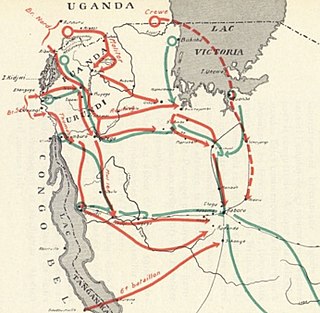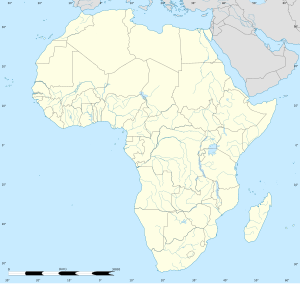
Paul Emil von Lettow-Vorbeck, popularly known as the Lion of Africa, was a general in the Imperial German Army and the commander of its forces in the German East Africa campaign. For four years, with a force of about 14,000, he held in check a much larger force of 300,000 British, Indian, Belgian, and Portuguese troops. He is known for never being defeated or captured in battle.

The Battle of Tanga, also known as the Battle of the Bees, was an unsuccessful invasion of the Port of Tanga in German East Africa by the British Indian Expeditionary Force "B" on 3–5 November 1914 during World War I. Under the command of the Major-General Arthur Aitken, British forces attacked Tanga in concert with Indian Expeditionary Force "C", which concomitantly attempted to capture Longido. The battle was the first major engagement of the East African campaign and saw Aitken's troops defeated by a smaller force of German Schutztruppen under Paul von Lettow-Vorbeck and forced to retreat. Lettow-Vorbeck's men captured weapons, medical supplies, tents, blankets, rations and several Maxim guns after the battle, which played a major role in allowing his troops to resist the Allies for the rest of the world conflict.

The Battle of Jassin was a World War I battle that took place on 18– 19 January 1915 at Jassin on the German East African side of the border with British East Africa between a German Schutztruppe force and British and Indian troops. Jassin had been occupied by the British in order to secure the border between British East Africa and German territory, but was weakly defended by a garrison of four companies of Indian troops, commanded by Colonel Raghbir Singh and numbering a little over 300 men. Colonel Singh was killed during the battle.

The Battle of Kilimanjaro at Longido took place in German East Africa in November 1914 and was an early skirmish during the East African Campaign of the First World War.

The African theatre of the First World War comprises campaigns in North Africa instigated by the German and Ottoman empires, local rebellions against European colonial rule and Allied campaigns against the German colonies of Kamerun, Togoland, German South West Africa, and German East Africa. The campaigns were fought by German Schutztruppe, local resistance movements and forces of the British Empire, France, Italy, Belgium, and Portugal.

The East African campaign in World War I was a series of battles and guerrilla actions, which started in German East Africa (GEA) and spread to portions of Mozambique, Rhodesia, British East Africa, the Uganda, and the Belgian Congo. The campaign all but ended in German East Africa in November 1917 when the Germans entered Mozambique and continued the campaign living off Portuguese supplies.

The South African Overseas Expeditionary Force (SAOEF) was a volunteer military organisation in World War I.

The Battle of Salaita Hill was the first large-scale engagement of the East African Campaign of the First World War to involve British, Indian, Rhodesian, and South African troops. The battle took place on February 12, 1916, as part of the three-pronged offensive into German East Africa launched by General Jan Smuts, who had been given overall command of the Allied forces in the region.
The Battle of Latema Nek took place during the East African Campaign in World War I.
The Battle of Kisaki was a confrontation between German and South Africa forces near the town of Kisaki, German East Africa, on 7–11 September 1916.

The Battle of Mahiwa between German and British Imperial forces was fought during the East African Campaign of World War I, when South African and Nigerian troops under Lieutenant General Jacob van Deventer engaged a column under German General Paul Emil von Lettow-Vorbeck, at Mahiwa in German East Africa. The Germans inflicted substantial casualties upon Van Deventer's army, forcing it to withdraw. However, the Germans lost a large percentage of their forces, and were ultimately forced to withdraw from their positions and continue their guerrilla war. The battle was noted by the British Official History as the "most disastrous day for the Nigerian Army since the formation of the force" and was called "the most savage battle in the history of African conflict-not excluding Omdurman or any engagement of the Boer War."

The Battle of Ngomano or Negomano was fought between Germany and Portugal during the East African Campaign of World War I. A force of Germans and Askaris under Paul Emil von Lettow-Vorbeck had recently won a costly victory against the British at the Battle of Mahiwa, in present-day Tanzania and ran very short of food and other supplies. As a consequence, the Germans invaded Portuguese East Africa to the south, both to supply themselves with captured Portuguese materiel and escape superior British forces to the north.
The Battle of Mlali was fought during the East African Campaign of World War I. In mid-August 1916, the British General Jan Christiaan Smuts led three divisions from Kenya south into the Imperial German colony of Tanganyika to seize and disrupt their vital railway. The German commander Paul von Lettow-Vorbeck was informed by his scouts of the British movement and sent Captain Otto to investigate.
The Battle of Kibata was fought north-west from Kilwa during the East African Campaign of World War I. The British theatre commander, South African General Jan Smuts, planned to seize Kibata and prevent German forces from withdrawing southwards.
Jan "Jacky" Willem Hurter Morkel was a South African international rugby union player, who also played first class cricket. Morkel played at centre for Somerset West RFC and Western Province. He was selected for South Africa for the 1912–13 tour of the Home Nations and France. He played in 18 games on the tour, including all five test matches, and scored four tries, two of them against Ireland. His brother, Gerhard, and his cousins 'Boy' and Dougie, were also on the tour. Jacky Morkel also represented Transvaal in cricket.

The Battle of Lioma was fought between the German Empire and British Empire during the East African Campaign of World War I. Having successfully evaded the Allies since late 1917, the German Schutztruppe under Paul von Lettow-Vorbeck waged a guerilla campaign in Portuguese East Africa, attacking and raiding settlements as well as forts in the search of supplies while inflicting as much damage as possible on the Allies. All the while, the Schutztruppe was chased by the British King's African Rifles, which finally cornered the Germans at the village of Lioma on 30–31 August 1918. Led by George Giffard, the British forces almost managed to encircle and destroy the Schutztruppe, but in the end the Germans broke out and successfully retreated. Although greatly weakened by the fighting at Lioma, the Schutztruppe was thus able to remain active until the end of the war.

The 1st Hull Heavy Battery was a unit of the British Army in World War I recruited from Kingston upon Hull in the East Riding of Yorkshire. It was the first unit of the Royal Garrison Artillery raised for 'Kitchener's Army' and it went on to serve as a howitzer battery in the East African Campaign and as a siege battery on the Western Front.

The Tabora Offensive was an Anglo-Belgian offensive into German East Africa, which ended with the Battle of Tabora in the north-west of German East Africa, it was part of the East African Campaign in World War I. The forces of the Belgian Congo crossed the border with German East Africa and captured the port city of Kigoma and the city of Tabora. In August a smaller Lake Force under the command of the South African brigadier general Crewe, launched a parallel attack from Uganda, also aimed at taking Tabora. The completion of the Tabora Offensive not only left much of the Ruanda-Urundi territory under Belgian military occupation but gave the Allies control of the important Tanganjikabahn railway.
Major Georg Kraut was born in Hildesheim by Georg and Auguste Kraut, née Hoppenstedt. Together with his four siblings Anne, Carl, Luise and Wilhelm Kraut, he grew up in a Lutheran family of lawyers. He was an officer of the Imperial German Army during the First World War, a veteran of the Schutztruppe, and the second-in-command of Paul von Lettow-Vorbeck. He was active in German East Africa. He participated in multiple battles, including the Battle of Tanga, the Battle of Salaita Hill, and the Battle of Iringa. Post-war, he joined the Freikorps with Lettow-Vorbeck and helped suppress the Spartacist Revolt.
The Battle of Namacurra was fought during World War I in Portuguese Mozambique between the First Portuguese Republic and their British allies against the German Empire. It took place on July 1–3, 1918, at the Namacurra River near Namacurra. It was the deadliest engagement of German general Paul von Lettow-Vorbeck's campaign into Mozambique; 209 of the British and Portuguese died.
















